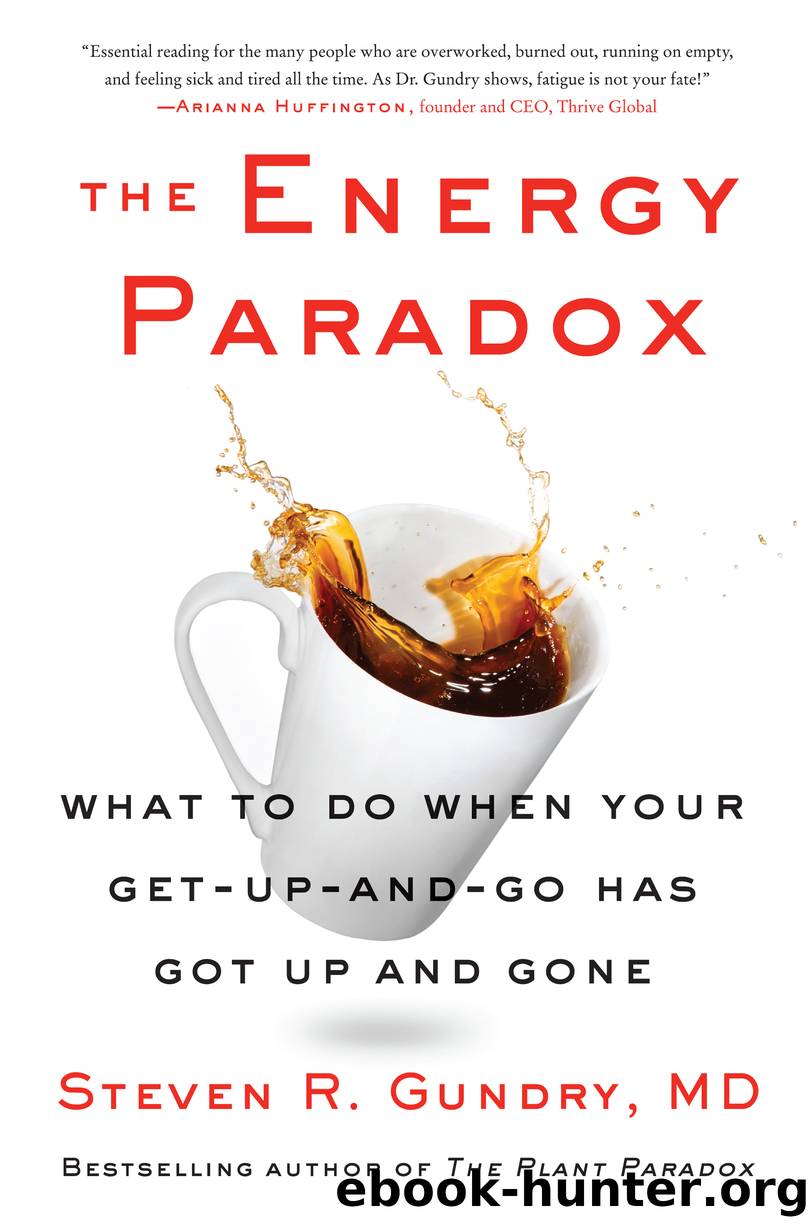Energy Paradox : What to Do When Your Get-up-and-go Has Got Up and Gone (9780063005747) by Gundry Steven R. M.D

Author:Gundry, Steven R., M.D.
Language: eng
Format: epub
Publisher: HarperCollins
Published: 2021-01-25T00:00:00+00:00
Energy Disruptor #3: Environmental Chemicals
Glyphosate isnât the only chemical we need to worry about; exposure to hundreds of chemicals of manmade origin is unavoidable today. More than one hundred thousand new chemicals have been introduced into our environment in the form of industrial and consumer products over recent decades.54 They pervade our homes, workplaces, food supply, and even our air, soil, and water, and at least three hundred of them or their metabolites have been measured in human biological samples. Youâre likely familiar with many of the categories of concernsâplastic-industry chemicals like bisphenols and phthalates, persistent organic pollutants and heavy metals, and, of course, pesticides, herbicides, and biocides, not to mention the fact that microplastics are even found in the plants we eat, which increase heavy metal loads in us.55 Though many are known as endocrine disruptorsâthey throw off the delicate balance of thyroid, insulin, and reproductive hormones and moreâand are associated with poor health outcomes, only fairly recently have scientists parsed how many of these effects may be mediated by the microbiome. Itâs beyond the scope of this book to break down every category of hazardous environmental chemical in detail. But it is crucial to take a broad-strokes look at how much these chemicals impair your energy potential.
First, most of these environmental chemicals appear to alter the gut microbiota. We know that exposure to chemicals like the plasticizer bisphenol A (BPA), which can leach out of food cans, microwaveable packaging, and some plastic bottles, reduces the gut buddies that make short-chain fatty acids and creates chronic intestinal and liver inflammation and metabolic disorder. BPA and its partner in crime, phthalates, also block receptors for thyroid hormone, even at low doses. Unfortunately, alternatives used (so that a product can be labeled âBPA-freeâ) are typically even less studied, rendering them potentially worse. Meanwhile, exposure to some of the industrial chemicals used in agriculture, in fast food packaging, and nonstick coatings for cookware have been shown to change the composition of the microbiome and incite inflammation in the intestines. Given how many Americans eat nonorganic food, fast food, and fried food, is it any wonder everyoneâs so tuckered out?
Second, many endocrine-disrupting chemical offenders you encounter daily are proved to be inflammatory.56 This may be partly because of the biome changes. As you know by now, inflammation drives not only obesity and immune dysregulation but also plain old fatigue.
In my deadly disruptor hall of fame, I have a special place for food preservatives, some of which stimulate the immune system; one in particular is TBHQ, a preservative used in most commercial seed oils and a lot of packaged fried foods.
Another hall of famer is chemical-based sunscreen. Research has shown that UV-filtering chemicals like oxybenzone absorb directly from your skin into your blood after one application, and by mimicking the effect of your natural hormones, disturb the vital and delicate hormone balance in your body.57 Iâve shared how chemical sunscreens lower your ability to convert vitamin D into its active form; weâre also learning
Download
This site does not store any files on its server. We only index and link to content provided by other sites. Please contact the content providers to delete copyright contents if any and email us, we'll remove relevant links or contents immediately.
Tools of Titans by Timothy Ferriss(7812)
Bodyweight Strength Training by Jay Cardiello(7674)
Born to Run: by Christopher McDougall(6893)
Inner Engineering: A Yogi's Guide to Joy by Sadhguru(6440)
Asking the Right Questions: A Guide to Critical Thinking by M. Neil Browne & Stuart M. Keeley(5355)
The Fat Loss Plan by Joe Wicks(4620)
Bodyweight Strength Training Anatomy by Bret Contreras(4465)
Yoga Anatomy by Kaminoff Leslie(4100)
Science and Development of Muscle Hypertrophy by Brad Schoenfeld(3970)
Dynamic Alignment Through Imagery by Eric Franklin(3919)
ACSM's Complete Guide to Fitness & Health by ACSM(3823)
The Four-Pack Revolution by Chael Sonnen & Ryan Parsons(3791)
Exercise Technique Manual for Resistance Training by National Strength & Conditioning Association(3786)
Bodyweight Strength Training: 12 Weeks to Build Muscle and Burn Fat by Jay Cardiello(3779)
Yoga Anatomy by Leslie Kaminoff & Amy Matthews(3737)
The Ultimate Bodybuilding Cookbook by Kendall Lou Schmidt(3706)
Yoga Therapy by Mark Stephens(3570)
Nutrition for Sport, Exercise, and Health by Spano Marie & Kruskall Laura & Thomas D. Travis(3556)
Nutrition for Sport, Exercise, and Health by Marie Spano & Laura Kruskall & D. Travis Thomas(3546)
